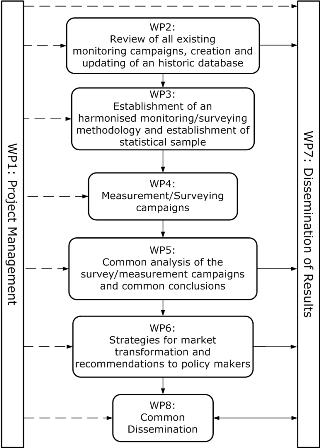Why REMODECE Project
Although significant improvements in energy efficiency have been achieved in appliances and lighting, the electricity consumption in the average EU household is still increasing by about 2% per year during the past 10 years and is expected to increase in the future if no measures are taken to counteract that trend.
The residential electricity consumption in 2004 for the EU-25 was close to 744 TWh and by 2015 is expected to significantly grow according to the following estimates by the IEA:
Consumption in 2015
Consumption with the Current Policies (TWh) |
854 |
Savings with LLCC (TWh) |
293 |
Savings (%) |
34.34% |
Efficiency policy can be used to target the most cost-effective level of efficiency (established through a life-cycle cost analysis [LLCC] and aiming at the technology improvement set at the least lifecycle cost) for appliances to be sold in the next decade.
The impact of vigorous market transformation activities in the residential sector in EU-25 by 2015 lead to 34% reduction of the electricity consumption in relation to business as usual), that is almost 300 TWh by 2015. This electricity savings translate into about 150 million tons of avoided CO2 emissions. In terms of primary energy savings, considering that most of the electricity generation expansion is the EU will be done with natural gas CCGT, and assuming 10% transmission and dis-tribution losses, about 60 Billion m3 of natural gas (most of which imported) could be saved. These figures represent of the most relevant cost-effective electricity savings potential in the EU.
The REMODECE project contributed to identify the policies required to carry out the market transformation required to tap this huge savings potential.
Top
REMODECE Project Step by Step
The proposed action was carried out in a matrix organization with a number of steps, which are main phases according to progress of time of the project. The steps were:
- Management;
- Review of all existing monitoring campaigns and creation and updating of an historic database;
- Establishment of a harmonised monitoring/surveying methodology and establishment of statistical sample;
- Measurement/Surveying campaigns;
- Common analysis of the measurement/surveying campaigns and common conclusions;
- Strategies for Market Transformation and recommendations to policy makers;
- Dissemination of results;

The REMODECE project was supported within the Intelligent Energy for Europe Programme of the European community (contract no. EIE/05/124/S12.419657). The kick-off meeting was in January 2006 and the project finished at September of 2008.
Total hits:
Top